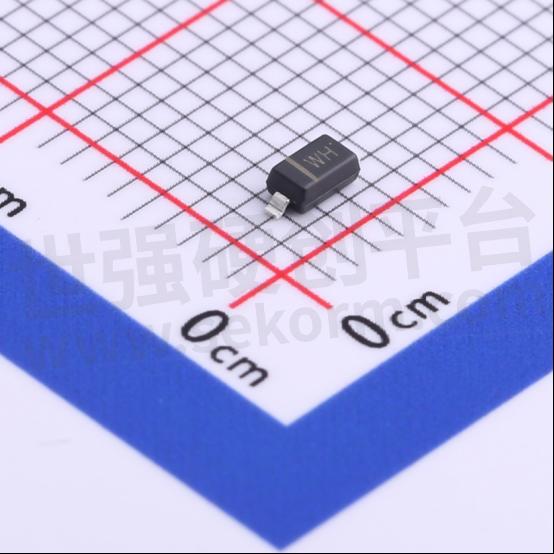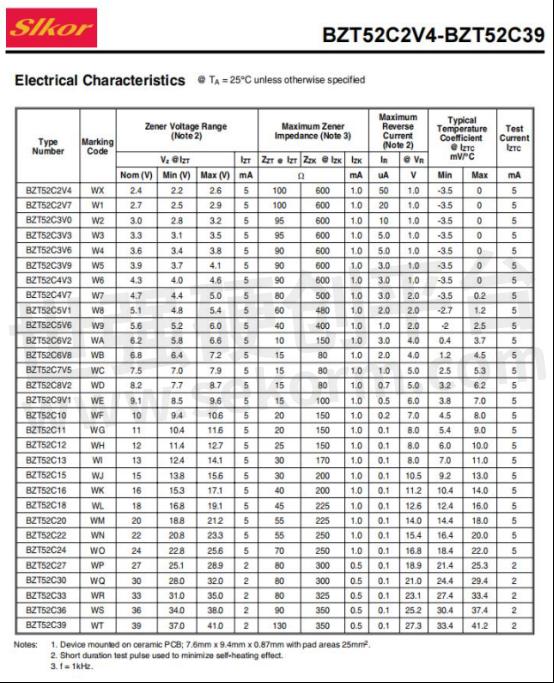Zener Diode BZT52C12: A Popular Choice in the Market

Within the vast family of electronic components, Zener diodes are highly favored by engineers and technicians for their unique voltage regulation characteristics. Among them, the BZT52C12 model Zener diode stands out as a popular choice in the market, renowned for its excellent performance and wide range of applications. This article will provide a detailed overview of the characteristics of the BZT52C12 Zener diode and its applications across various fields.

SLKOR Voltage Regulator Diode BZT52C12 product photo
I. Basic Parameters of BZT52C12 Zener Diode
● The core feature of the BZT52C12 Zener diode lies in its stable output voltage. The nominal Zener voltage of this model is 12V, meaning under normal operating conditions, its output voltage remains stable around 12V. Additionally, the Zener voltage ranges between 11.4V and 12.7V, providing engineers with flexibility during design and application.

Slkor Voltage Regulator Diode BZT52C12 specification
● In terms of accuracy, the BZT52C12 Zener diode boasts a ±5% tolerance, ensuring minimal fluctuation in output voltage suitable for a wide range of applications. Furthermore, it supports a power rating of 500mW, ensuring stable operation even under high load conditions.

Parameters of Slkor Voltage Regulator Diode BZT52C12
● Regarding reverse current (Ir), the BZT52C12 Zener diode performs exceptionally well with a reverse current of only 0.1μA. This indicates minimal current flow through the diode under reverse bias, thus reducing energy consumption and heat generation.
II. Applications of BZT52C12 Zener Diode
● Power supply circuits
● Reference voltage sources
● Linear regulators
● Surge protection
III. Methods for Identifying Zener Diodes
Visual Characteristics
● Shape and color: Zener diodes typically appear as short black cylinders with two leads. While colors may vary by manufacturer and model, black is commonly used.
● Markings: Zener diodes are typically labeled with text and numbers providing model and parameter information, including manufacturer name, model, date, batch number, etc.
Textual Markings
● Model identification: Zener diodes are often labeled in circuits with "ZD" followed by a number, e.g., "ZD5" for Zener diode number 5. These markings help determine the diode's characteristics and parameters.
● Parameter information: Textual markings may also include parameters such as Zener voltage (Uz), reverse leakage current (Iz), dynamic resistance (Rz), etc., crucial for correct selection and identification of Zener diodes.
Electrical Performance Parameters
● Zener voltage (Uz): Stable voltage produced across the Zener diode terminals under rated current. This value may vary slightly with operating current and temperature.
● Reverse leakage current (Iz): Current flowing through the diode when maintaining stable voltage. Operation below this value can degrade Zener performance, while higher currents within rated power dissipation are permissible.
● Dynamic resistance (Rz): Ratio of voltage change to current change across the Zener diode terminals. This ratio varies with operating current, typically decreasing with increasing current.
● Rated power dissipation (Pz): Determines allowable temperature rise based on stable voltage (Vz) and maximum current (Izm) ratings.
Testing and Verification
● Multimeter testing: Use a multimeter to measure reverse and forward resistance of the Zener diode for initial operational assessment, ensuring correct polarity connections.
● Multiple verification methods: When identifying Zener diode models and parameters, utilize multiple verification methods. Compare visual characteristics, textual markings, and electrical performance parameters to enhance accuracy.
Considerations
● Beware of counterfeit products: Exercise caution when purchasing Zener diodes to avoid low-cost, counterfeit products lacking proper markings or parameter information, or disguised appearances.
● Reference relevant sources: When determining Zener diode models and parameters, consult various resources such as manufacturer websites, Zener diode manuals, electronic commerce sites, etc. These sources provide extensive product information and technical parameters, aiding accurate model and parameter determination.
- +1 Like
- Add to Favorites
Recommend
- In-depth Analysis of BZT52C12S Voltage Regulator Diode: Performance, Applications and Characteristics
- Slkor BZT52C5V6S: Precision Zener Diode for Voltage Regulation with A VZTyp rating of 5.6V and A Maximum Power Dissipation of 200mW
- The Voltage Regulator Diode BZT52C36 Features A Maximum Power Dissipation of 500mW and A Stable Voltage Value of 36V
- The Voltage Regulator Diode BZT52C30 Features A Maximum Power Dissipation of 500mW and A Stable Voltage Value of 3.6V
- The Voltage Regulator Diode BZT52C2V4 Features A Maximum Power Dissipation of 500mW and A Stable Voltage Value of 2.4V
- The Voltage Regulator Diode BZT52C10 Features A Maximum Power Dissipation of 500mW and A Stable Voltage Value of 10V
- The Voltage Regulator Diode BZT52C11 Features A Maximum Power Dissipation of 500mW and A Stable Voltage Value of 11V
- The Voltage Regulator Diode BZT52C3V6 Features A Maximum Power Dissipation of 500mW and A Stable Voltage Value of 3.6V
This document is provided by Sekorm Platform for VIP exclusive service. The copyright is owned by Sekorm. Without authorization, any medias, websites or individual are not allowed to reprint. When authorizing the reprint, the link of www.sekorm.com must be indicated.






























































































































































































































































































































































































































































































































































































































































































































































































































































































